
Is there anything more miserable than wearing wet clothes? Growing up in Cornwall, UK, which has an average of 156 rainy days per year, and a propensity to offer up all four seasons in one day, I’ve done my fair share of rainy dog walks, thru-hikes, and bike rides. If I stayed inside each time that the weather was foul, frankly, I’d never go out, which means that a good waterproof jacket has become one of my staples.
Not all waterproof jackets are created equally, and while a see-through poncho might be perfectly sufficient for a rainy festival, it won’t be much help in a mountain storm. Here’s what you need to consider.
What is the difference between water-repellent and waterproof?
If you want proper protection against the elements, buy a jacket that is waterproof, not merely water-resistant. Water-resistant gear will offer some protection against light showers, but lets water in very quickly.
A waterproof jacket stands up to much harsher conditions, but if you don’t purchase one that's breathable, you’ll get moisture build-up on the inside of the coat instead. When engaging in intense exercise this will still leave you soaked and uncomfortable. Looking for a coat with a waterproof membrane is a good way to ensure that it will be breathable and allow moisture to escape. You’ve probably heard of Gore-Tex, the most famous waterproof membrane on the market. It works by using small pores that are small enough to stop drops of rain from getting into your jacket, but large enough to let your sweat wick out. Gore-Tex is far from the only waterproof membrane on the market these days, and many outdoor brands now have their own versions.
If your jacket isn’t as waterproof as it once was, the good thing is that you don’t necessarily have to buy a new one. A durable water-repellent coating (DWR) is applied to the outside of a water-resistant or waterproof jacket, and if your jacket starts to lose its impermeability, it’s very easy to reapply a DWR yourself. To see if your jacket needs a DWR top-up, splash it with water and see if the water beads and slides off. If it does, you’re fine. If it leaves dark, wet patches of fabric instead, it’s time to buy a DWR replenishment product and recoat your coat.
How can I tell what degree of protection a waterproof jacket will give me?
There’s a helpful scale for this, and many outlets will list a waterproof rating next to their jackets. 5,000mm is the minimum level of waterproofing required for a coat to be considered waterproof, and not merely water-resistant, but this level won’t stand up to much more than light showers and drizzle. 10,000mm–15,000mm will withstand most downpours, and 20,000mm and upwards is for really heavy deluges and extreme conditions, but the jackets are generally much heavier.
What fit should I go for?
Since you’re unlikely to be running around in just a bikini and a waterproof jacket, buy a jacket that gives you enough room to layer. For three-season hiking, a waterproof jacket that allows you to wear a base layer and a down jacket underneath should be sufficient, but if you’re partaking in winter mountaineering you’ll want something roomier to allow you to layer up.
What other features are useful?
Look for jackets with taped seams. This means that the inside seams have been sealed, stopping water from getting in through the small holes. Storm flaps are another practical extra: outer flaps that cover jacket zips, another porous area where rain can get in. Personally, for most adventures, I like a rain jacket with a peaked hood. This keeps the rain out of your eyes, whereas jackets that only have a drawstring hood let rain trickle down your face.
Ready to have epic adventures in all weather? Let’s dive in.
Input may receive a portion of sales if you purchase a product through a link in this article. We only include products that have been independently selected by Input's editorial team.
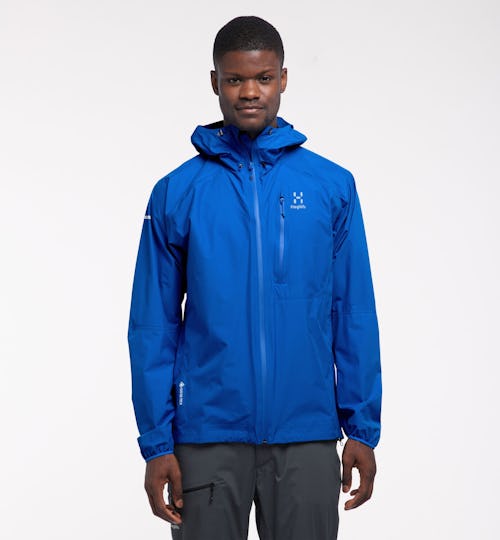
When I’m trying to keep weight down on a trip, I always take my Haglofs L.I.M Jacket, which weighs only seven ounces and stuffs into my pocket. Although the material is really thin, it’s made from Gore-Tex and withstands heavy showers with minimal leaks. The pocket placement is extremely practical for thru-hiking with a pack. One is a vertical pocket at chest height and the other is a diagonal pocket just above the hip, meaning that you can still easily access your phone even when wearing a hiking backpack with hip and chest straps. The reinforced peak on the hood effectively keeps water out of your eyes.
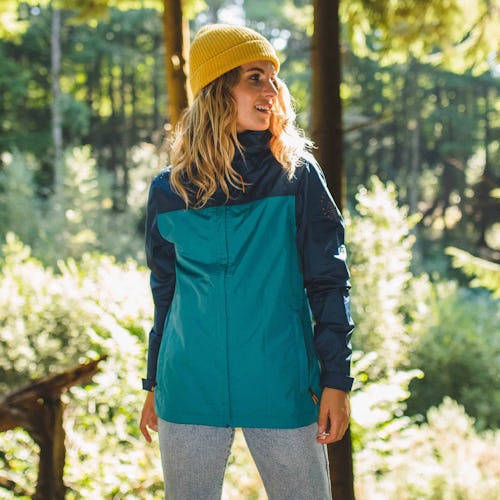
The jacket is made from sustainable materials and even the packaging on the Passenger Latitude Recycled Waterproof Jacket is fully recyclable and plastic-free. A peaked hood minimizes rain trickling down your face and all of the seams are taped. The outside of the jacket is covered with PFC-free water-repellent coating, which can be topped up if it starts to wear, meaning that this jacket will stay waterproof for years.
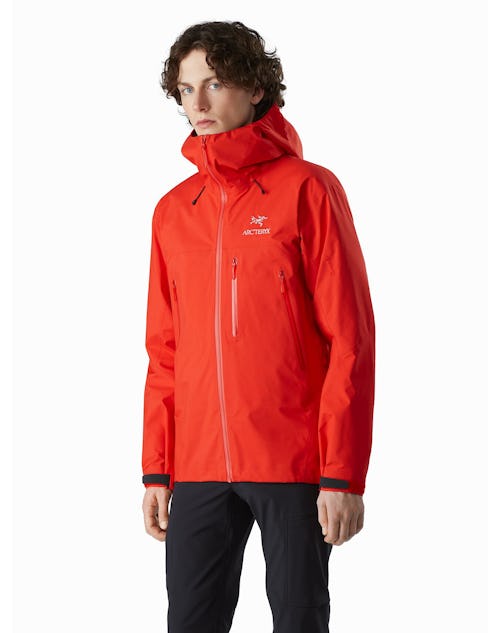
The Arc’teryx Beta SV Jacket isn’t cheap, but it's built for the harshest of environments. It’s fully waterproof, windproof, and breathable to boot, with zipped underarm ventilation to allow moisture to escape. The chin guard is made from brushed microsuede, so you can keep this jacket zipped up to your nose in bad weather without the risk of chafing. There are plenty of pockets, including inner pockets to keep valuables safe and dry in deluges. This is a coat built for alpine conditions.
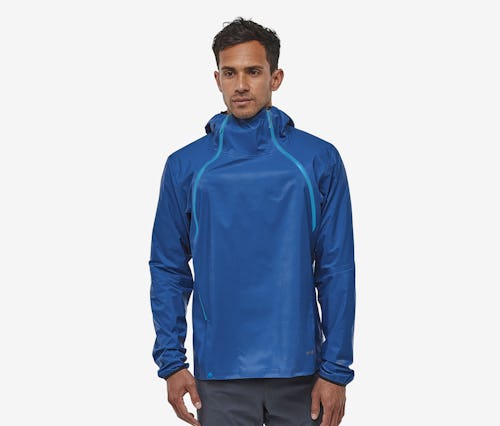
The Patagonia Storm Racer Waterproof Running Jacket has two long zips on the chest which unzip the jacket like a bib, making it a good choice to pair with a trail-running vest or hydration pack. The 3-layer waterproof shell is extremely lightweight, and the whole coat can be stowed in its own pocket, it’s that compact. The hood is drawstring rather than peaked, which makes the jacket compact, but means it’s a better choice for a trail run rather than a multi-day jaunt in the mountains.
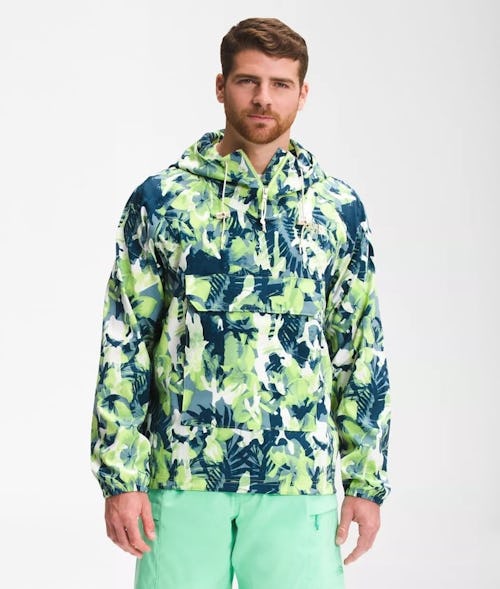
The North Face Fanorak is a good one for festivals. The color-block design and the way that it transforms into a fanny pack with a zipped pocket on the front means that it looks fashionable and keeps your valuables safe. The adjustable hood and elastic cuffs offer good protection from the wind, too. It’s water-repellant rather than fully waterproof, so it’s best for use in milder conditions.
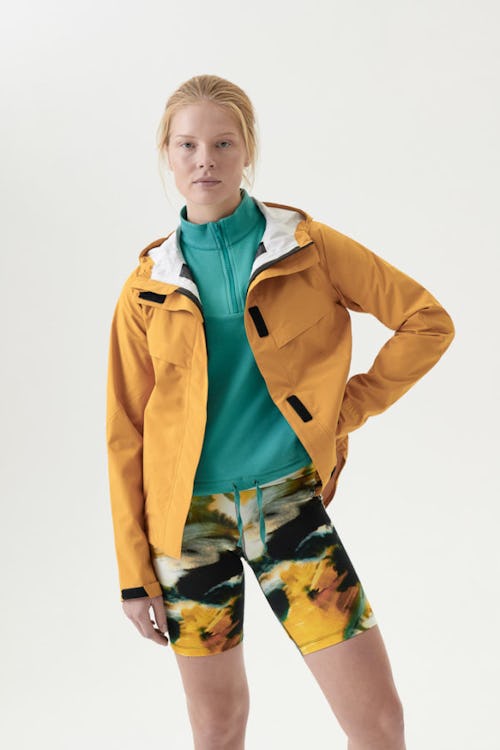
Ninety-eight percent of the BAM Longaford Waterproof Jacket is made from recycled materials, and the cut is longer than on most coats to protect more of your body. It comes with mesh ventilation and a breathable membrane to aid moisture to escape, and the fully taped seams and velcro fastenings offer added rain protection in areas vulnerable to water leaks. The sizing runs a little small, so if you’re layering up, consider buying a size larger than normal.
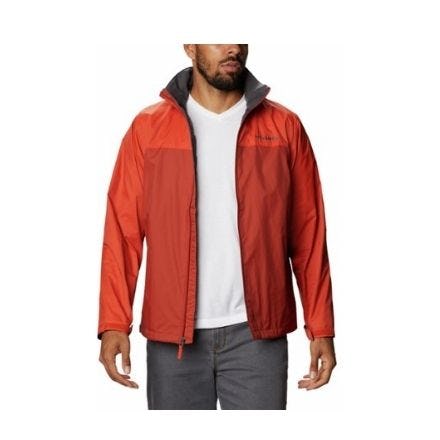
The Columbia Glennaker Lake Lined Rain Jacket is water-repellent rather than waterproof, so it’s better suited to light showers, which at this price is hardly surprising. The polyester lining keeps wearers warm and the cut is very practical for offering wind and water protection; the cuffs and hem are both adjustable, and there's a high chin.

The Páramo Women’s Ventura Jacket uses a Nikwax (breathable, elastic water-repellent) technology which evacuates 80 percent of moisture collected and drains it away, and has plenty of ventilation for temperature control. This jacket is designed for high-intensity sports in extremely cold conditions where wearers work up a sweat, but feel the chill quickly when they stop moving, like skiing, ice climbing, and snowboarding. The peaked hood still slots easily under a helmet and goggles, and it’s extremely refreshing to see a women’s jacket with so many functional pockets.







